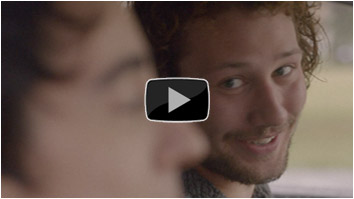Safer P Platers.com.au
Everything you need to get through the red together.
Stay involved. Stay safe.
You’ve done the hard work to get your young driver their 120 hours of experience. You’ve gone through the dos and don’ts on the road and now those yellow ‘L’ plates have been replaced by shiny red ‘P’ plates.
Just because the learner plates have gone it doesn’t mean that your role should stop. Your young driver still looks to you for advice and guidance.
The first six months are the most dangerous time for young drivers so we’ve designed this website to help reduce their risks.
On these pages you’ll find common situations that affect newly licensed drivers along with information on how you can play your part to help keep them safe on the roads with strategies such as picking them up from social functions, letting them drive the safer family car on long drives or putting their mobile in the boot to avoid temptations. We have also created an E-Learning module to help you get through the red together.
By using the tips on this site to talk to your p-plater about driving safe you can help them earn their first full licence for free.
Stay involved and get through the red together.
Night Driving
What’s the risk?
Remember when you first got your licence? How you wanted to take your friends everywhere, regardless of the time of day or night? Well times haven’t changed that much and your young driver will probably want to do the same.
Driving at night is more risky than during the day for the following reasons:
- Visibility is reduced at night and so is the time a driver has to recognise and respond to potential hazards.
- With the majority of social functions also occurring after dark, there’s also a pretty good chance your young driver will be driving around after a day of study or work and potentially a bit of sport – they might not know it, but the chance is that they’ll be fatigued.
- It is important to remember that they are on the road with others who may have had a drink or are fatigued too.
These situations on their own are dangerous for your young driver, but when combined the risk increases for your young driver at night.
How can you help.
You can’t keep them off the road forever, but you can ease your new solo driver into night driving. You can also share your own experiences of driving after dark.
Don’t hesitate to remind them of the facts; such as driving after 17 hours awake is the equivalent of having a blood alcohol reading of .05.
Encourage them to leave the car at home and catch public transport to social functions – it’s easier to make good decisions early rather than late at night when all they want to do is get home.
If they do drive - it never hurts to give them another option in case they feel it’s unsafe to drive home. Let them know that the ‘mum and dad taxi’ is still available or give them some ‘just in case’ cab money.
For more information on how you can help see the fact sheet on night driving check out the the TAC's fatigue campaigns.
Speeding
What’s the risk?
Judging and controlling your speed when you haven’t got much experience is tricky. It’s easy for new drivers to unintentionally exceed the limit, resulting in less time to notice and avoid hazards.
How can you help.
Speed limits are the maximum allowable speed for the type of road and environment, making it safer for all road users. Remind your young driver to adjust their speed for the conditions and not to exceed the speed limit.
Many GPS devices have speed limit alerts. If your young driver has access to one, encourage them to use it but remind them to set it before starting to drive. It means they can be aware of their speed without taking their eyes off the road.
There are many times when it might not seem like it, but what you do still has strong influence on your young driver. So the best thing you can do is continue to lead by example and reinforce their safe driving habits when you’re in the car with them.
Check out the TAC’s speed campaigns.
Drink Driving
What's the risk?
The majority of young people get their licence at 18 or 19, the same age that they are legally allowed to drink alcohol.
Alcohol slows reaction times and affects decision-making ability, and this is why our most inexperienced drivers are not allowed to drive with alcohol in their system, all P-plate drivers must have a zero blood alcohol reading.
How can you help.
The good news is that most P-platers stick to the zero BAC limit most of the time, but good kids still make mistakes. As a parent you can remind them about the importance of this rule and ensure they are not tempted by being in tricky situations.
Make sure they're aware of the law, penalties and potential consequences of drink driving.
If you know your young driver is planning a night out, it's not a bad idea to discuss with them how they are getting home. Do they have a plan or could you offer to pick them up? It is important to remember that the first few months of driving will be the first time in life that young drivers are confronted with making choices around alcohol and it's easier to make good decisions before they start drinking.
Vehicle Safety
What's the risk?
Young drivers often drive the oldest and least safe cars on our roads, providing a lower level of protection in the event of a crash.
For a lot of young drivers safety isn't as big a priority as a car's look and performance. Price is often the main criteria when choosing a car and you might think that a safe car is unaffordable.
How can you help.
Parents often assist their child with their first vehicle purchase. Sometimes this involves financial assistance, and sometimes just advice, but whatever your role, do whatever you can to get them into the safest vehicle in their price range.
When helping your child choose a first car, err on the side of caution and go with the safe choice. The How Safe is Your Car website allows users to search by price range and has an option for p-plater approved vehicles. These days safety doesn't have to be expensive. Until your child has their own car, you might be able to let them drive the safer family car.
Decision Making
What’s the risk?
Youth is a time when we make mistakes and often learn by trial and error. This is a normal part of growing up. Unfortunately bad decisions made behind the wheel can have fatal consequences.
Young drivers often find that with their new found freedom comes new situations, new people and new influences. Because of this they can find their decision-making ability compromised, particularly by their peers and by alcohol.
How can you help.
We know you can’t be there 24/7 and it’s highly unlikely that they’re still clearing every decision with you.
But you can encourage them to plan ahead, avoiding the need to make snap decisions at times when their mates are able to influence them.
Know how they intend to get home. Be aware of their plans and make sure they know that they can always be picked up by you or get a cab. Sometimes the best driving decision they can make is not to drive at all.
Peer Pressure
What's the risk?
Travelling with two or more peer-aged passengers significantly increases their risk of crashing. That's why there are peer passenger restrictions for red P drivers.
Bowing to peer pressure and getting a regrettable hair cut won't kill anyone, but peer pressure that results in poor driving decisions can.
How can you help.
Understand that your kids are going to stay out late and they're going to do things that you rather they didn't. Youthful experimentation is a fact of life after all.
While it's fine to party with friends, it's not fine to party in the car. Good kids can still make mistakes, so encourage them to speak up to avoid getting into potentially risky situations.
For more information check out:
- VicRoads Graduated Licensing System page
- VicRoads Probationary Driver Kit.
Distractions
What's the risk?
Driving a car is one of the most complex tasks we undertake and requires full concentration. Taking your eyes off the road to tune the stereo, answer a call or set the GPS, even for just a couple of seconds, can result in devastating outcomes. Taking your eyes off the road for two seconds at 50km/h is the equivalent of driving 27 metres effectively blind.
How can you help.
Distractions can come from technology (such as mobile phones), from passengers or from external distractions in the road environment.
You can encourage a young driver to completely remove the potential distraction of a ringing mobile by putting it in the boot until they reach their destination. If they need to make a call or reset the GPS, encourage them to pull over at a safe place.
There are also applications available that can stop a mobile ringing in transit while still getting a message through to the caller like Do Not Disturb mode.
Remember it's a good idea to remind your young driver to stay focused when behind the wheel.
Bad Weather
What’s the risk?
Fog, hail, storms and high winds are weather conditions that young drivers seldom encounter when learning, but will inevitably encounter when they get their licence.
As a new driver without experience it can be difficult to judge appropriate speeds in changing conditions, or know to increase the travelling distance from the car ahead to stay safe.
How can you help.
Many young drivers think that if the posted speed limit is 60, then that’s the speed they should be travelling. Remind your young driver that there’s nothing wrong with driving a little under the speed limit, or pulling over if conditions get overly treacherous.
Fog, rain and other poor weather conditions can result in poor visibility. Make young drivers aware that, while pulling over to stay safe may add time to their journey, a collision will add a lot more and it’s always best to play it safe.
Long Drives
What’s the risk?
It would be nice if we could keep new drivers in their own familiar neighbourhoods while their solo driving experience increases. Unfortunately this isn’t realistic. With a licence and a car comes the opportunity to travel to places further afield, be it for work, study or social gatherings.
Long distance driving generally involves extended stints behind the wheel in unfamiliar surroundings, which can result in fatigue and difficulty concentrating on the driving task. It is important that young drivers are adequately prepared for any long journey.
How can you help.
It’s natural for teenagers to want to put some distance between themselves and their parents. It’s best that they build up long distance driving experience over time.
When your young driver is ready to drive long distances, plan the trip well in advance. This involves working out rest stops every two hours, how to best share the driving and whether there are any unique road conditions to consider.

